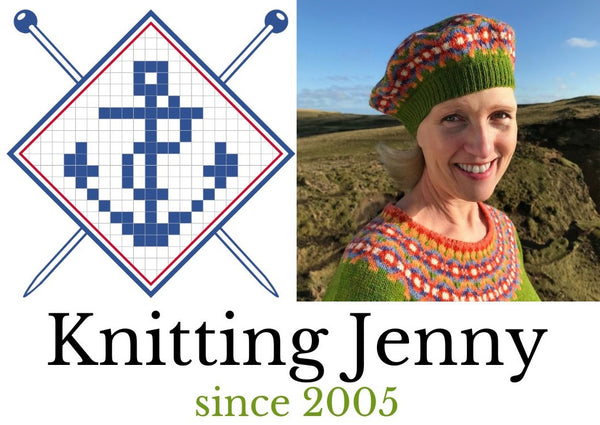Color Dominance in Fair Isle Knitting
Jennifer Daley
Above is an image of Knitting Jenny Pattern 32, a Fair Isle fisherman's kep hat that I designed when I had a home and studio in Fair Isle, Scotland in 2023. While knitting this pattern, I paid close attention to the important technique of color dominance.
In stranded colorwork, the term “color dominance” refers to the yarn color that is primary (dominant), which appears in the pattern more prominently. This is in opposition to the secondary (non-dominant) color that serves as a “background” to the pattern.
Understanding the fundamentals of color dominance will help achieve a knitted product with more uniform stitches and a higher quality appearance.
The above Knitting Jenny Pattern 32 includes a maximum of two colors in a row. This maximum coloring per row is the standard in Shetland knitting. In other knitting cultures, it is acceptable to include more than two colors in a row and to potentially include purl stitches as a design feature on the right side of the knitting (such as in the Swedish Bohus style stranded colorwork).
When knitting with two colors in stranded colorwork, it is important to be aware of how knitting technique and color dominance affect how the colors appear in the knitted fabric.
You can choose to knit purely for pleasure and be unconcerned about how the yarn is held in your hand or how your knitting technique affects the overall aesthetic of the final knitted piece. I encourage you to knit as you want to knit. All knitting techniques are valid!
However, I would also like to encourage you to consider the importance of understanding color dominance. Many years ago, when I came to understand the theory of color dominance, my knitting vastly improved——quickly and effortlessly.
In most Fair Isle inspired knitting patterns, there are light colored yarns and dark colored yarns, to create contrast. This contrast between light and dark is an important requirement of authentic Fair Isle knitting. To benefit most from color contrast, it is important to be aware of how the two yarns are held while knitting.
I would like to encourage you to consider holding the yarns (and knitting) in a consistent manner. Consistency is key to uniform stitches and ultimately a higher quality knitted piece.
Firstly, when viewing a knitting pattern, decide which color is primary (dominant) and which color is secondary (non-dominant).
The foreground color is the primary color. To ensure that the primary color appears dominant, when knitting hold the foreground color UNDER the other yarn. This method will ensure that the stitches in the foreground color (and motif) will be ever so slightly larger and more apparent.
The background color is the secondary color. To ensure that the secondary color appears non-dominant, when knitting hold the background color OVER the other yarn.
Knitting Know-How in a Nutshell:
1st YARN = Foreground, primary, dominant color, hold wool under, place the yarn on the left side of the body, and carry the yarn in the left hand.
2nd YARN = Background, secondary, non-dominant color, hold wool over, place the yarn on the right side of the body, and carry the yarn in the right hand.
